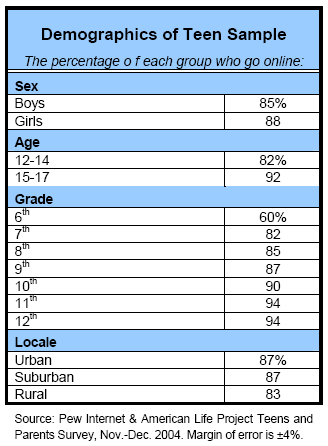Introduction: Demographics
According to the latest Pew Internet & American Life Project telephone survey fielded in October and November 2004, 87% of American youth aged 12 to 17 go online.4 That represents roughly 21 million teens who use the internet in some aspect of their lives. The online teen population has increased by roughly 24% since we last asked this question in a survey in December 2000.5 On the flip side, 13% of American teenagers do not use the Internet. About half (47%) of teens who say they do not go online have been online before but have since dropped off.

Parents of teens are also much more likely to go online than the average American adult. Some 80% of parents who have teenagers go online, compared to 66% of all American adults. Parents with teenagers who use the internet have even higher levels of connectivity, with 84% of them reporting internet use.
African-Americans are the least likely to be online.

In our current survey, white6 and English-speaking Hispanic7 teens are more likely than African-American teens to report going online. Among whites, 87% of teens say they go online. Similarly, 89% of Hispanic youth in this study say they go online. By comparison, 77% of African-American youth go online. All three of these groups are more likely to be online than the overall population of American adults, of whom, 66% go online. Teens of all races are also more likely to be online than their parents. Overall, 80% of parents go online, and 84% of parents of online teens go online themselves. When broken down by race, 82% of white parents and 81% of English-speaking Hispanic parents go online. By stark contrast, just 62% of African-American parents go online. In all cases, however, parents are more likely to go online than non-parents, regardless of race or ethnicity.
Most teens have logged on by the 7th grade.
Starting Junior High seems to be the moment when most teens who were not previously online get connected. About 60% of the 6th graders in our sample reported using the Internet. By 7th grade, this number jumps to 82% of teens who are online. From there, the percentage of internet users in the teen population for each grade climbs steadily before topping out at 94% for all 11th and 12th graders. Much of the lag among 6th graders appears to come from boys. Less than half (44%) of 6th grade boys report going online, compared to 79% of 6th grade girls.

Older teens, aged 15-17, go online more frequently than younger teens. Some 59% of wired teens aged 15-17 go online once a day or more, while 43% of younger teens report going online that frequently. By comparison, 11% of 12- to 14-year-olds say they go online every few weeks, compared to just 6% of older teens.
Only 6% of 6th graders go online several times a day compared to one-quarter (25%) of 8th graders and close to 2 in 5 (39%) 12th graders. On the other side of the use spectrum, one in five (20%) of 6th graders go online just every few weeks compared to a mere 8% of 8th graders and 5% of high school seniors.
Teens from the poorest families lag behind.
As is the case with adult use of the internet, teens from the lowest-income families are the least likely to report use of the internet. Teens from households earning under $30,000 per year are less likely than any other income group to report internet use. Less than three-quarters (73%) of teens from these families use the internet. By contrast, 90% of teens from families earning more than $30,000 a year go online. At the highest income levels, households earning more than $75,000 a year, 93% of teens go online.

Teens with married parents are significantly more likely to go online than teens of single parents. Eighty-nine percent of teens with parents who are married go online compared to 76% of teens with parents who are divorced, separated, widowed, or who have never been married.




